A designer was asked this by a prospective client in a Skype meeting, and she froze like a deer in headlights.
“There are lots of designers out there… why should I hire YOU specifically?”
If you suspect that you’d probably have the same reaction (freezing in fear, unsure of how to respond), well, we’ve got some work to do, so read on.
This is probably one of the most common struggles I see with designers: an inability to articulate the value they can bring to the client.
There are many issues at play here including: process and workflow issues, confidence, and positioning. Just be aware, that if you struggle with this, you are in good company! I’ve seen this issue pop up time and time again, and as someone who has struggled with my own business confidence, I really needed to address this.
First things first.
It’s a totally fair question for a client to ask, yes?
They’re not necessarily trying to grill you or catch you off-guard… they legitimately want to know what makes you different from the sea of designers out there (and yes, there is a sea of them!)
An inability to answer this question usually signals one or more of the following issues:
- You don’t know your own value (or how to articulate it)
- You don’t have a solid, dependable process
- Your positioning is weak
- You lack confidence (or suffer from imposter syndrome)
(Hint, these things are all related)
Let’s address each of these problems, so that you can start to get more comfortable with the inevitability of the question: “Why should I hire you?”
Problem:
You don’t have a solid, dependable process
I used to think I was winging it with clients, just working from intuition. The truth is, I had a process, I just hadn’t articulated it yet. There was a reason I would make certain decisions along the way, and while every project felt different, there were very real commonalities between projects that I could point to.
While every client project is unique, I have my go-to processes that outline how to approach each part of the project depending on the client’s comfort level with design language, technology, or even how far along they are with their content development. I may show wireframes in some instances, while jumping right into a prototype with another client.
It’s not because I’m disorganized; my ability to read what a client needs at each phase in the project allows me to adapt and be flexible, meeting them where they are. That is my superpower. My process is built to be flexible, so that even when I’m thrown a curveball, I have a number of approaches I can take.
Now it’s your turn to nail down your process.
Solution:
You need to design a repeatable process for how you approach your projects.
When you design a solid, dependable process, it makes it much easier to separate yourself from your process, allowing you to talk to clients about the value of your process, and not your own person worth/value (which can be much more challenging).
Review this post: Why you need to design the experience of working with you.
Then, map out your own project process, and look for ways to start streamlining and automating what you do.
If you are beginning to take on projects that you’ve never done before, and aren’t sure how to you talk about how you’d approach it…
The easiest way to break down a project approach is this methodology:
- What is the current situation?
- What is the desired outcome or situation?
- What would it take to get there?
- How will we measure success?
What is. What if. How so. Is it working.
You don’t have to know the answer to these questions; just know that you can count on this process for any project that you take on.
Find out where the client is currently (new or existing business, traffic, social engagement, content, assets, workflow, website, etc), where they want to go (help them determine their big goals and dreams), what strategy and tactics they’ll need to get there (if you’re doing strategy work, this is what you’ll help them figure out through your work together), and how you’ll measure that your collaboration is a success (what metrics will you use?).
What you do in each of those stages and how you do it (tools and approach) is really your secret sauce.
Problem:
You don’t know your own value (or how to articulate it).
I’ve mentored and worked with a lot of designers, and being a human being myself, I know what it means to question your own value and experience. (See also: imposter complex.)
It can also be exceptionally difficult to quantify the estimated value that you can bring to a project, especially if you’re approaching a new type of project that’s outside of your current expertise.
Solution:
1. Take Inventory of the clients and projects you’ve worked on:
- Which projects had the best results?
- What kind of results are you able to get for your clients?
- Which did you enjoy working on?
- What patterns have you noticed in your successful projects?
- Where do you consistently shine?
- What do your clients frequently thank you for?
- How do your friends and colleagues typically compliment you?
If you can’t answer this question, you need to ask some of your closest friends (business and otherwise) what they see as your natural strengths.
Hint: these don’t have to be all “business” or technical skills
2. Make a brag sheet.
It’s really too easy to get down on ourselves for not being good enough, and we set our goals so high, we forget to look at how far we’ve come and what we’ve accomplished. Go ahead, and make a brag sheet. I’m serious.
List all of your successes, highlights, wins, testimonials, and things people have thanked you for. Look for the patterns that showed up in your project/client inventory. Where have your most profitable projects come from? How about the most fulfilling?
3. Take some personality/strengths tests:
Take the StrengthsFinder 2.0 test. There is a free version of this test here.
This test was really useful for me personally in really understanding and articulating my specific strengths.
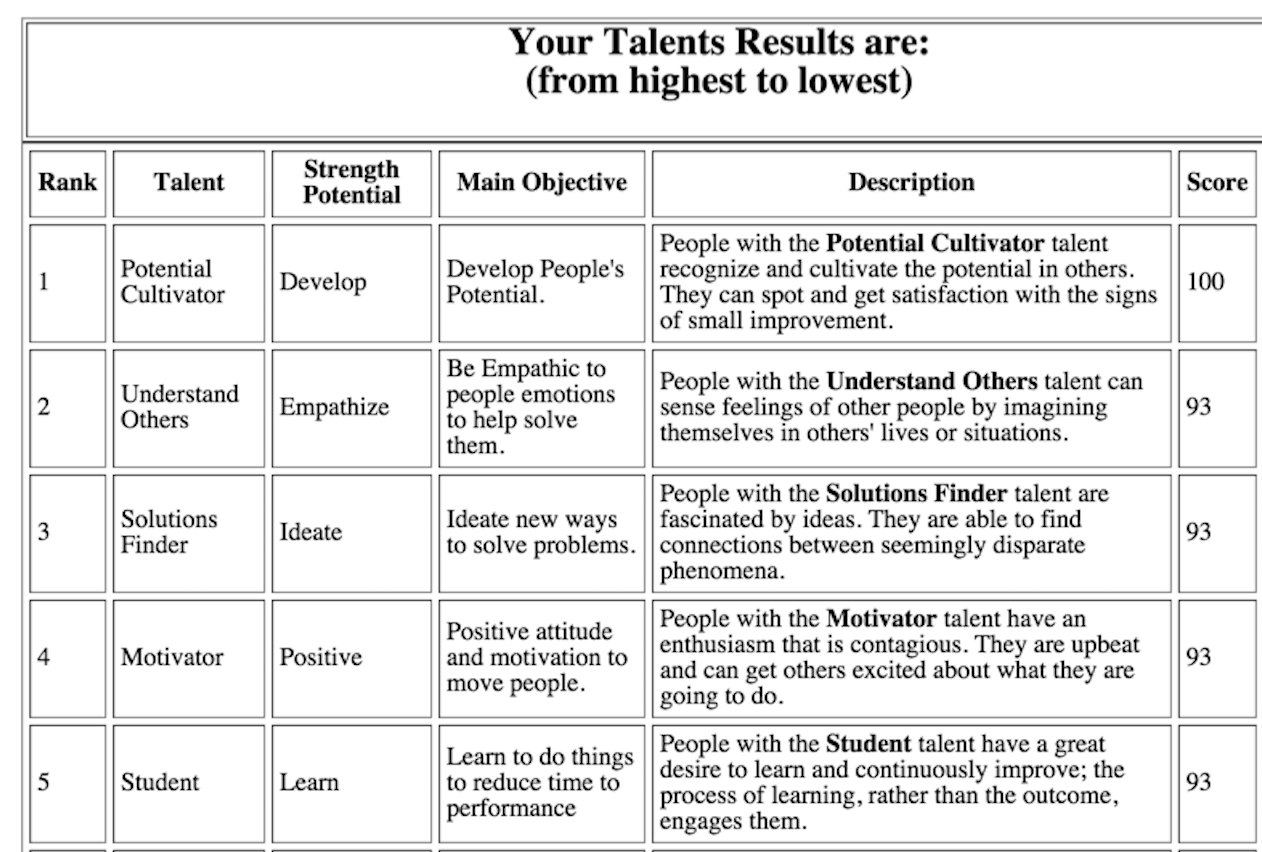
I didn’t even know “potential cultivator” was a thing! Did you??
Looking at my strengths, it makes complete sense that I was drawn to running a mentorship program. I get really excited about helping other people grow and thrive, and this was a reminder to me that not everyone is motivated this way. (You can’t run a mentorship program when you don’t LOVE people!) I create impact by helping others create impact.
When you take an honest look at both your top 5 and lowest 5 strengths (they don’t call them weaknesses, they just list all the strengths in order from highest to lowest), and compare alongside friends and business buddies, you start to see how the value that you bring to the table is related to you utilizing the skills, talents and strengths that come most naturally to you.
The StrengthsFinder 2.0 book gives a lot more detail about each strength, which might help you find some key wording that you can utilize in your bios, taglines, and especially your “work with me” page. Notice how I’ve built in a lot of language that really gives a good indication of what it’s like to work with me. There are no surprises here: I push people out of their comfort zones, the process is highly tailored and non-linear, and it’s a long-term engagement.
Sally Hogshead’s Fascination Advantage test helps you identify and understand what other people find fascinating about you, so that you can leverage it in your marketing. Essentially, your “fascination advantage” is how your personality is most likely to add distinct value.
My archetype is The Talent, with my primary triggers as Passion (I connect with emotion) and Prestige (I earn respect with higher standards).
Here’s The Talent‘s overview:
A ROLE MODEL FOR PEERS AND CUSTOMERS, YOU SET THE BAR HIGH, AND ENCOURAGE OTHERS TO WORK TO RAISE IT.
- You have a high “emotional intelligence.” You quickly ascertain what someone needs from you in order to buy in to your ideas.
- You excel in relationships with others, including employees, clients, friends and family.
- Whereas others may become lazy or complacent with their place in life, you seek out new goals and challenges.
- You constantly seek ways to improve, gain new experiences and expand your sphere of knowledge.
WHO YOU ARE:
- Expressive
- Intuitive
- Social
- Impulsive
- Enthusiastic
HOW YOU ADD VALUE:
- You captivate others with your vibrant and attractive style of communication.
- Your approachable and transparent style makes you an “open book.”
- You intuitively understand ideas and feelings of others.
So what does all of this mean?
You want to make sure that the services you offer, and your positioning are in line with your natural strengths.
I used to try to avoid getting too friendly with clients because I’d always heard that it was unprofessional. Well, that’s a load a horse manure, and once I finally embraced that emotional intelligence and warmth was a huge asset of mine, I decided that friendliness, approachability, and my down-to-earth nature was part of my BRAND.
My desire to connect deeply with people led me to choose to only work with long-term engagements. Meanwhile, I know the very thought of that gives some designers nightmares. That’s the beauty of leveraging your strengths: you get to do what makes sense for you, even if it doesn’t make sense for anyone else.
One of the ways I’ve taken “open book” to the next level in my business is by taking on clients who are willing to let me show my students a complete behind-the-scenes of the work unfolding live in real-time (including actual budgets, proposals, communication and process!).
An aside:
Back in 2010, when I was doing my final portfolio review/assessment in order to get my design degree, the interviewees left comments mostly based on my personality and not my portfolio! At the time I figured this meant I sucked. And to be fair, I probably did at the time.
On my feedback form was:
“We really liked how you seemed to be enjoying the interview!”
and:
“You’ll do fine in any place you decide to work!”
Essentially, forget the portfolio: you’re easy to get along with!
I wasn’t sure how to take this at the time, but I understand now that my ability to make others feel at ease, my energy, warmth, and my emotional intelligence is actually what wins me the projects, smooths out the workflow, and makes it effortless to create community. All of this was in fact my superpower; I just hadn’t embraced it yet.
What is your superpower?
16 Personalities is a slight variation on the Meyers Briggs personality tests which is based on Carl Jung’s analytical psychology concepts. This test helps you understand how you move through the world, and gives you an overview of your strengths & weaknesses, how you handle romantic relationships, parenthood, your career path, and your workplace habits.
 When I look at my specific personality archetype (The Campaigner) and my strengths, I notice some similarities with both the Fascination Advantage and Strengths Finder:
When I look at my specific personality archetype (The Campaigner) and my strengths, I notice some similarities with both the Fascination Advantage and Strengths Finder:
Energetic and Enthusiastic: Infectious enthusiasm that leads to more social connections.
Excellent communicators: strong people skills, adept at steering conversations towards their desired subjects in ways that feel completely natural and unforced.
Observant: every move and every idea is part of something bigger.
Curious: don’t hesitate to step out of comfort zone. Imaginative and open-minded, seeing all things as part of a big, mysterious puzzle called life.
As you can see by the image, I pretty much move through the world based on how things feel, and what my intuition tells me. Wow, 82% feels! Not surprising…
Taking a look at these three tests, you can start to build some language and understanding around what you uniquely bring to the table with your approach. Do not underestimate the power of your personality and approach over your “design skills.”
You have to be willing to OWN YOUR EDGES.
Problem:
Your positioning is weak.
Positioning is the mindshare you occupy in the mind of your client. It is a consumers perception of your brand or product relative to your competitors.
Consider those apple ads:
“Hi, I’m a Mac!”
“And I’m a PC!”
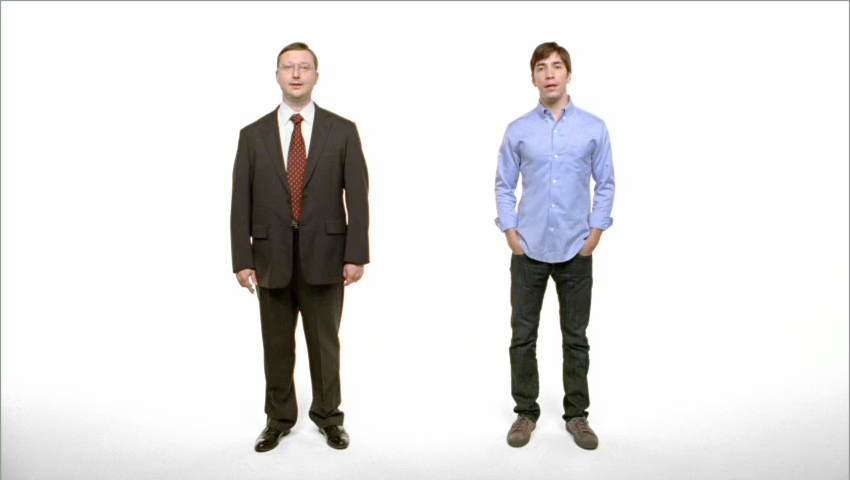
That ad campaign is positioning personified.
We understand what Apple is implying here: that PCs are the stuffy, clunky, boring, corporate option, while Apple is the trendy, hip, down-to-earth, user-focused option. Apple is appealing to certain lifestyle and prestige factor. While we may or may not be over-paying for computing prowess, we’ve come to know that Apple’s focus on user experience means that their products are friendly, approachable, and extremely user-friendly. Apple products fit into an integrated ecosystem that make using their products delightful, and we’re willing to pay a premium for that experience.
While you’re not necessarily a big corporation, you represent a position in the market, whether you realize it (or decide on it) or not.
We tend to make purchasing decisions based on emotion, and not simply logic. We’re not always looking for the least affordable option.
So what space do you want to occupy in the mind of your prospective clients?
Are you the friendly, affordable web designer? Are you the sought-after premium designer with a waiting list of 6 months? Do clients save up their pennies to work with you, or are they working with you because they just need the job done quick and dirty?
Now, I will say this over and over and over again: positioning is a process. I repeat.
Positioning is a process.
As business owners (and especially as web designers and strategists), we should always be growing and learning. This means that we have never really “arrived”; we are in a constant state of growth and flux.
When we choose a market position, this is a role that we grow into. Sometimes that means targeting a specific segment of a market (ex: website design for yoga studios), doing a specific type of work (ex: online course design and strategy), or working with a certain type of person (ex: social innovators).
My own positioning has morphed over the years as I’ve gotten more clarity on the types of projects I’m best suited for, where my natural strengths lie, and the kind of impact I want to create.
Solution:
Decide to be the go-to person for ____.
Essentially, you want to be the go-to person for something. What is that something?
This can take years to figure out, and it will often change year after year as you get more clarity. As my friends Kai Davis and Philip Morgan would say, when it comes to Positioning, “try it on.” Try a position, and if it doesn’t work out (not enough interest or sales, or it doesn’t feel right), you can change it! Try it on, test it out, tweak and iterate.
How the heck do we figure out what we’re best suited for?
Hopefully by this point you’ve assembled your brag sheet, identified your strengths, and honed in on your relevant experience and interests.
The key here?
You don’t have to be the best at this thing.
You just have to be known for that thing. Be clear and consistent about how you describe what you do.
Make it known in your email signature, your homepage, about page, work with me page, social profile pages, and in conversations. Practice writing and re-writing your bio to start moving toward your place of desired expertise. You won’t get it on the first try; treat it as an evolution.
But above all else be memorable; stake your claim!
Problem:
You lack confidence or suffer from Imposter Syndrome.
So the big secret here is that almost everyone suffers from Imposter Syndrome. I hired Tanya Geisler to help me with this last year (if you suffer from this, you absolutely must follow (or hire) Tanya to get your head on straight. Or sign up for her upcoming Step Into Your Starring Role program; it’s a game-changer!)
There’s being the best, being an expert, and there’s have “expertise” and/or experience.
In “So Good They Can’t Ignore You,” author Cal Newport says that what makes ridiculously successful people so successful is they’re experts at practicing.
You’re unlikely to ever learn all there is to learn about one particular subject or area of expertise. There is always more to know and learn. So essentially, you have to let go of this idea that when you just learn a little more about this, or a little more about that, THEN you’ll be “ready.”
You don’t have to be an expert to be extremely useful and have impact on your clients.
Another highly subjective area of “expertise” is relevant experience. In many industries there are not clear-cut degrees or certifications that deem one an expert, and furthermore relevant experience may make you an expert even if you didn’t study a field formally.
Daniel Newman
Do you know more than your clients? Great, keep learning. No? Great, keep learning.
Solution:
Let go of the idea that you need to be the best (or perfect).
Don’t wait to position yourself as the go-to person for something until you are “the expert,” or until you’re “ready.”
Now of course, you don’t want to lie about your experience. If you have very little experience in the area that you want to specialize, then it’s time to INTERN. This means taking on projects at a lower rate to gain experience, or working longer hours on projects because you’re choosing to use it as a learning experience. Find ways to put in those 10,000 hours.
Here is a definition of expert that comes from Dreyfus’s model:
Experts don’t apply rules, or uses any maxims or guidelines. They rather have intuitive grasp of situations based on their deep tacit understanding… Based on prior experience, they can even come up with solution for new never experienced before situations. “Experts” adopt a contextual approach to problem solving and understand the relative, non-absolute nature of knowledge. This ability distinguishes the “expert” from the “proficient” practitioner. Reflection comes naturally and experts solve problems almost unconsciously.
You can become known for something and be ridiculously useful without being the best. Forget being the best, just commit to getting results. Results speak for themselves. Testimonials speak for themselves. Client happiness speaks for itself. Gather your authority thesis (as Tanya Geisler calls it); the evidence that shows you really are an authority. (Your inner negative self talk is horribly biased unfortunately).
Negative self talk? That sh*t is:
1. Boring
2. Not true
3. Seriously really tired
The first few years of establishing yourself in both your business and your expertise are uncomfortable to say the least. You’re often reinventing the wheel every time, because you haven’t yet sorted out what works and what doesn’t. That’s ok; keep going. Commit to learning, and remember that no one remembers you in your amateur phase. They remember you when they see your awesomeness shining everywhere, which takes time, and bold, consistent effort.
“Very few people have the humility to start as amateurs. They procrastinate doing the work they want in the name of perfectionism. You know these people. The one’s who have been saying for years that they’re going to do something but never do. Yet inwardly, they’re terrified of what other people will think of them. They’re caught in a state of paralysis by analysis — too busy calculating and never reaching a state of flow. Rather than doing work their own way, they do what they think will be well-received — being merely imitators of what is already popular.”
— Benjamin Hardy
OUCH. And so true.
So we’ve established that you’re still learning your craft—wonderful!
Now what do you want to be known for?
Assemble your Unique Value Proposition:
A business or marketing statement that summarizes why a consumer should buy a product or use a service.
For _____________ (ideal/target audience) who __________________ (their need), _______ (product or company) is ____________ (product category or description) that (the key benefit) ______________.
or
_______ (product or company) is ____________ (product category or description) for _____________ (the ideal/target audience) who __________________ (their need), that (the key benefit) ______________.
For Digital Strategy School, that sentence could read:
What’s your unique value proposition?
To summarize:
- Design a dependable, repeatable process and workflow that you can rely on.
- Get clear on your natural strengths and skills.
- Stake your claim: decide to be the go to person for something.
- Let go of perfectionism: accept that you’re still learning, and that doesn’t prevent you from providing value now.
SO, why should I hire you?
When your client asks you: “why should I hire you?”, do you know how to respond?
When you know your strengths, you’re clear on the work you do (and who you do it for), and you can articulate your unique value proposition, it makes it a heck of a lot easier to answer the dreaded question: why should I hire you?
If you made it this far, and found this post useful, I’d love to know your thoughts! Feel free to leave a comment below, or hit me up on Twitter!
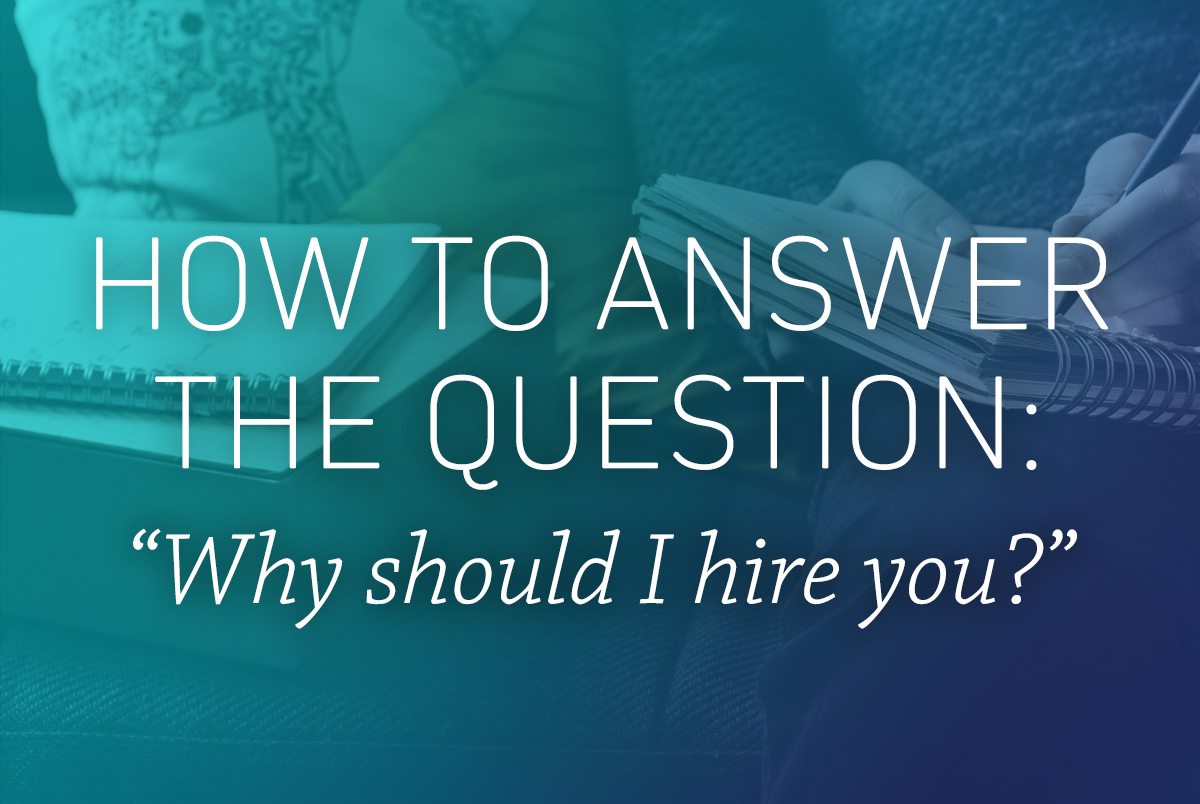

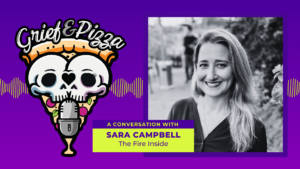
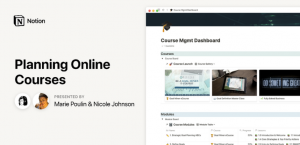
Thanks Marie. Great post! Very helpful and practical
Marie, I love how you broke this down into actionable tips. I love it because at one time or another this question will come up!
I love what you said about confidence/Imposter Syndrome. The online world seems full of “experts” and “gurus” and I’m still in the learning phase (as we all should be, right?). It’s easy to fall into the trap of thinking we can’t be useful until X happens. Thanks for addressing that mindset!